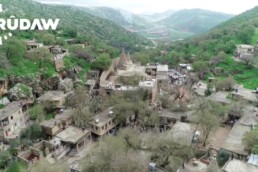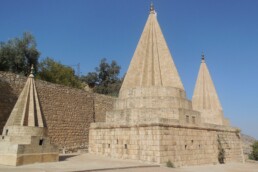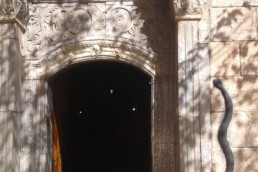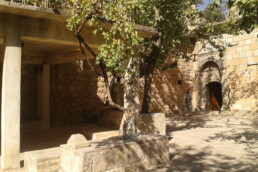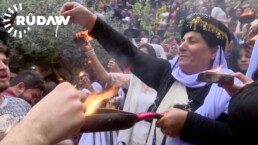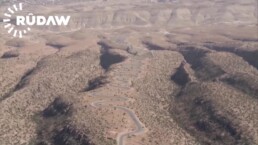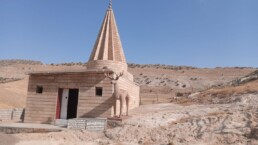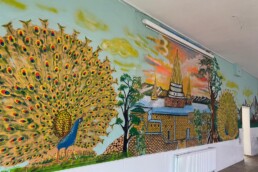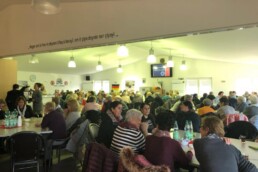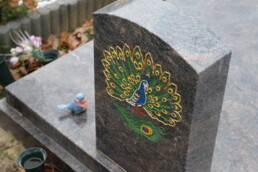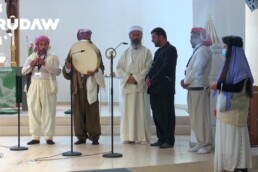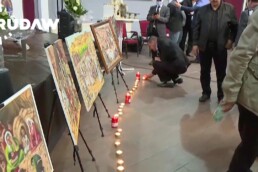Yazidis and Yazidism
Yazidis are members of a Kurdish-speaking ethno-religious group. The traditional settlement areas of the Yazidis are in the border areas of Turkey, Syria and Iraq. Yazidis call the area where they make up the majority Êzîdxan (‘house/area of God’). Today the main settlement area of the Yazidis is in northern Iraq, where around 400,000 people used to live in the Sinjar region and around 200,000 in Kurdistan Region. However, due to historical persecution, only about 500 Yazidis still live in Turkey and about 3,000 in Rojava (northern Syria). With around 200,000 individuals, Germany has the largest Yazidi community outside the traditional settlement areas. There are about one million Yazidis worldwide.
History, Religion and Culture
General
Yazidism is an independent faith that can not be derived from other religions. The roots of the faith go back several thousand years and are, therefore, older than Christianity. Yazidism is monotheistic. Yazidis believe in one God (Xwedê) as the creator of the universe, who is unique, omnipotent and omniscient. In addition, the archangel Tawisî Melek (angel peacock) is worshipped. There is no notion of an adversary to the divine will. Yazidis do not use any holy scriptures. Existing writings are said to have been destroyed or falsified during persecution, deportations and genocides by radical Muslims, especially during the Ottoman Empire. Instead, religious traditions and beliefs are passed down orally. The Yazidis are divided into lay people (Mirîd) and clergy (Ruhanî). One is born a Yazidi when both parents are Yazidi. The religious centre is the Laliş sanctuary in northern Iraq, in the Kurdistan Region.
The sanctuary of Şêx Adî (Laliş) is the most beautiful of all sanctuaries. It's green there. There are many trees there.
— Survivor. In: Women for Justice e.V.: Yazidis and the on-going genocide. Information booklet, 2021, p. 14. (freely translated from German)
Holidays
There are numerous Yazidi festivals throughout the year. During these times Yazidis visit holy places which have often a white tower. The Yazidis are very connected to nature in their religious practice. While in the traditional settlement areas, trees themselves are considered places of pilgrimage in honour of saints and trees at pilgrimage sites are particularly respected, April is considered the ‘Bride of the Year’ when weddings usually do not take place (because Mother Earth is considered the most beautiful bride). With the festival at the beginning of the year on Çarşemba serê Nîsanê (‘Wednesday at the beginning of April’) or Çarşemba Sor (‘Red Wednesday’), which takes place on a Wednesday in April, the birth of the world is commemorated. It is considered a festival in honour of Mother Earth.
The fasting days at the end of the year last for three weeks. The first week is in honour of the sun and the light (Şêşims), the second week in honour of the ancestors and saints (Xudan) and the third week in honour of God. In the third week, the biggest Yazidi festival of the year, Cejna Êzî, also Îda Êzî, is celebrated in honour of God. Êzî is one of the names of God and the namesake of the community (Kurdish Êzîdî). Each week fasting takes place from Tuesday to Thursday. Each Friday is considered a public holiday. The third Friday is the biggest holiday. The Cejna Cimayî (‘Assembly Feast’) in honour of reformer Şêx Adî (lived in the 12th centtury) and honouring the meeting of the seven angels is celebrated for a week in October at the central temple of Laliş. Every Yazidi should participate in this celebration once in their life.
On holidays, we got up early in the morning and went to the graves of our deceased, where there was a holy temple. We prepared our food the night before. We ate the food together at the sanctuary. This is our tradition. (...) If I die one day, I would like to be buried there too. My heart is deeply rooted in Yazidism.
— Survivor. In: Women for Justice e.V.: Yazidis and the on-going genocide. Information booklet, 2021, p. 11. (freely translated from German)
Geographics and Life in Sinjar
Sinjar is the name of a province in northern Iraq whose capital bears the same name. While the north of Sinjar borders Syria, the south abuts the Arab part of Iraq. The Sinjar Mountains run through the area, which consists of various districts and villages. As part of the Ba’ath Party’s Arabisation or so-called modernisation policy, Arabs were settled in the city of Sinjar in the 1970s. Most of the Yazidi villages in the mountains were dissolved, and the people were forcibly resettled in newly created localities on the edge of the mountains. Most Yazidi temples and sanctuaries are located in the Sinjar Mountains, up to 1,500 m high.
The majority of Sinjar´s population consists of Yazidis. Most of them live in village and family communities. Festivals are big occasions, eating together is very important, with the regional cuisine consisting of many meat dishes. Traditional clothing is worn by the elderly or on special occasions. Tobacco and figs from Sinjar are known nationwide. To this day, many people make their living from agriculture. However, after the genocide in 2014, which is on-going, unemployment was extremely high.
There is no place more beautiful than Sinjar. The mountains are beautiful, and some curves climb high. (...) Sometimes we took our animals with us to the pasture. The mountains were partly closed but mostly open. It was particularly beautiful in Kersê, and the sanctuary of Pîraxa was also beautiful. Many people have made a trip here. (...) Whenever I wasn't in Sinjar, I always wanted to return quickly. That was my place of well-being.
— Survivor. In: Women for Justice e.V.: Yazidis and the on-going genocide. Information booklet, 2021, p. 18. (freely translated from German)
Yazidis in Germany
Immigration to Germany
The first Yazidis, mostly men, came to Germany between 1964 and 1973 as part of the recruitment agreement signed in 1961 between the Federal Republic of Germany and Turkey. In the years that followed, Yazidis migrated to Germany as part of family reunions or applied for asylum as a consequence of the military coup in Turkey in 1980, which saw Yazidis persecuted because of their ethnic affinity as Kurdish and a religious minority. While the administrative court in Stade (Germany) recognised the Yazidis as a persecuted group as early as 1982, it was only in 1992 that Yazidis were generally granted asylum under German law. Towards the end of the 1990s, only a few hundred Yazidis remained in their villages in Turkey. Many Yazidi immigrants in Germany applied for German citizenship and had no plans of returning.
Since the 1980s, Yazidis have been fleeing Syria, Iraq and the CIS countries. The Syrian civil war, which has been raging since 2011, and the violence committed by the Islamic State in Syria and Iraq have caused a particularly large refugee movement to Germany.
In their countries of origin, the Yazidis have suffered persecution and social exclusion for centuries, so in the Ottoman Empire and later in the successor states of Turkey, Syria and Iraq. This brought also economic consequences. As a result, most Yazidis found a new home in Lower Saxony and North Rhine-Westphalia (Germany). As a result, the number of Yazidis in Germany is estimated at 200,000 today. Before the attacks by the Islamic State in Syria and Iraq against Yazidis in 2014, the number was estimated with 100,000. Thus, the biggest Yazidi diaspora community lives in Germany.
My first child! I had to leave my daughter Sükriye with my mother-in-law when I went to Germany. When she fell ill, my father got Sükriye. She lived with my parents for three months. I had to wait for her for over a year! My father brought her to Germany. We were a family again!In: Yazidi and rural women in conversation. Strangers, friends. 2010, p. 43f. (freely translated from German)
I met my husband from my home village in Celle. We married in 1975, away from our families. Of course, I continued to work after getting married. (...) We lived modestly, saved and finally bought an old house in Celle. We continued to support our parents and parents-in-law.In: Yazidi and rural women in conversation. Strangers, friends. 2010, p. 62. (freely translated from German)
The Muslims in Turkey persecuted us. (...) My parents once took the bus to see their parents. Some passengers had noticed that Yazidis were travelling on the bus. At the next stop, many Turks came; at least a hundred people wanted to get the Yazidis off the bus to kill them. The bus driver closed the windows and tried to drive on. People rattled and shook the bus, almost toppling it over. My parents thought they were never coming home. They were ill from this horror for a week, and today they still talk about it with great fear.In: Yazidi and rural women in conversation. Strangers, friends. 2010, p. 82. (freely translated from German)
In Istanbul, I sent my long skirts and dresses home – this is Europe, everything is different here, so I bought trousers. But the headscarf remained for the time being. After a medical examination, I flew to Germany with many other women; the German employer paid for the outward flight. (...) We were accommodated very primitively, e.g. there was a water tap in the wall but no basin underneath. The toilet had no flush and could be reached via the courtyard. Oh, worse than in Turkey, a catastrophe!In: Yazidi and rural women in conversation. Strangers, friends. 2010, p. 99f. (freely translated from German)
Yazidi Communities
Most Yazidi associations were founded in the 1990s. However, different spellings can still be found in the association names: Yazidi, Jesidi, Ezidi, Êzîdî. The first Yazidi community centre was built in Celle in 1993, where the largest Yazidi community lived outside the traditional settlements for many years. The communities aim to promote cultural preservation and mediation – both internally and externally. The community centres, therefore, provide a space for religious festivals, funeral services, native language lessons or folklore, but also for conferences and seminars.
Today’s association landscape is divided between political views, regions of origin or the designation of identity. Parts are discribing themselfs only as Yazidis, others as Yazidi Kurds. There are umbrella organizations (e.g. Central Council of Yazidis, Central Association of Yazidi Associations and Umbrella Organisation of the Yazidi Women`s Council). There is also an association/network of village communities, numerous sports and artists’ associations and community centres (e.g., Celle, Bergen, Oldenburg, Emmerich, Kleve and Wesel). Some associations focus on professional interests, such as the Society of Yazidi Academics or the Association of Yazidi Lawyers. The Yazidi television station, Çira TV, is based in Löhne. There are separate Yazidi cemeteries in Germany. The largest of these is in the city cemetery in Hanover-Lahe. Others exist in Emmerich am Rhein, Bochum and Herford.
Selection of Yazis Associations
Vocal Point for Yazidi Affairs
State Association of Yazidis in Lower-Saxony
Umbrella organization of the Yazidi Women’s Council e.V. (only available in German)
Yazidi Cultural Center Wesel e.V. (only available in German)

